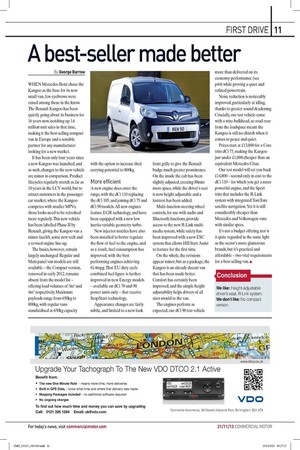A best-seller made better
Page 7

If you've noticed an error in this article please click here to report it so we can fix it.
By George Barrow
WHEN Mercedes-Benz chose the Kangoo as the base for its new small van, few eyebrows were raised among those in the know. The Renault Kangoo has been quietly going about its business for 16 years now, notching up 1.6 million unit sales in that time, making it the best-selling compact van in Europe and a sensible partner for any manufacturer looking for a new market.
It has been only four years since a new Kangoo was launched, and as such, changes to the new vehicle are minor in comparison. Product lifecycles regularly stretch as far as 10 years in the LCV world, but to attract customers in the passenger car market, where the Kangoo competes with smaller MPVs, those looks need to be refreshed more regularly. This new vehicle has been labelled Phase II by Renault, giving the Kangoo van a minor facelift, some new tech and a revised engine line-up. The basics, however, remain largely unchanged. Regular and Maxi panel van models are still available — the Compact version, removed in early 2012, remains absent from the model list — offering load volumes of 3m3 and 4m3 respectively. Maximum payloads range from 650kg to 800kg, with regular vans standardised at 650kg capacity
with the option to increase their carrying potential to 800kg. More efficient
A new engine does enter the range, with the dCi 110 replacing the dCi 105, and joining dCi 75 and dCi 90 models. All new engines feature EGR technology, and have been equipped with a new low inertia variable geometry turbo.
New injector nozzles have also been installed to better regulate the flow of fuel to the engine, and as a result, fuel consumption has improved, with the best performing engines achieving 61.4mpg. That EU duty cycle combined fuel figure is further improved in new Energy models — available on dCi 70 and 90 power units only — that receive Stop/Start technology. Appearance changes are fairly subtle, and limited to a new-look
front grille to give the Renault badge much greater prominence. On the inside the cab has been slightly adjusted, creating 88mm more space, while the driver's seat is now height adjustable and a footrest has been added.
Multi-function steering wheel controls, for use with audio and Bluetooth functions, provide access to the new R-Link multimedia system, while safety has been improved with a new ESC system that allows Hill Start Assist to feature for the first time.
On the whole, the revisions appear minor, but as a package, the Kangoo is an already decent van that has been made better. Comfort has certainly been improved, and the simple height adjustability helps drivers of all sizes mould to the van. The engines perform as expected, our dCi 90 test vehicle
more than delivered on its economy performance (see p44) while proving a quiet and refined powertrain.
Noise reduction is noticeably improved, particularly at idling, thanks to greater sound deadening. Crucially, our test vehicle came with a wire-bulkhead, so road-roar from the loadspace meant the Kangoo is still no church when it comes to peace and quiet.
Prices start at £13,000 for a Core trim dCi 75, making the Kangoo just under £1,000 cheaper than an equivalent Mercedes Citan.
Our test model will set you back £14,800— second only in cost to the dCi 110— for which you get a more powerful engine, and the Sport trim that includes the R-Link system with integrated TomTom satellite navigation. Yet it is still considerably cheaper than Mercedes and Volkswagen vans with similar specs. It's not a budget offering, nor is it quite regarded in the same light as the sector's more glamorous brands, but it's practical and affordable — two vital requirements for a best-selling van. •
We like: Height-adjustable driver's seat, R-Link system. We don't like: No compact version.






































